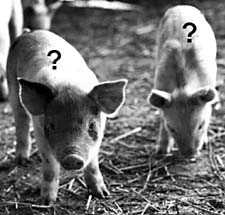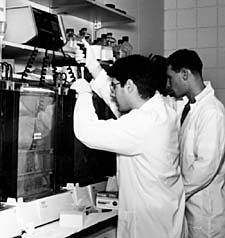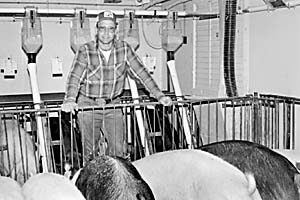Gene Mapping and the "Bottom Line"
| "The science of technology defines what is possible; a study of the economics of technology establishes which of the possibilities is practical and useful." —Montgomery Phister |
Why care where genes are within an animal? Because it allows us to tell at a micro-glance whether an animal is likely to develop or pass along to its young a particular desirable or undesirable trait. That means being able to predict production characteristics and disease susceptibilities in newborn pigs, and so make better management decisions. It means being able to better identify whether a particular sow or boar is likely to produce offspring with certain desirable or undesirable traits.
The bottom line is that gene mapping provides the means for a faster and more efficient selection of good production characteristics and quicker and more thorough elimination of undesirable ones. It means saving time and production costs.

| Which—if either—of these gilts will carry on their dam's tradition of producing a large number of superior-quality young? Today, it's anybody's guess. Tomorrow, genome mapping may reveal the answer, giving producers the chance to select future breeding stock early in life. |
But that's not all. Knowing where to find a gene is also a key first step in being able to study how it does what it does. This in turn may lead to new techniques for enhancing positive production traits and reducing or eliminating negative ones or developing ways in which to modulate such traits.
Ultimately, mapping efforts converge toward the goal of improving the quality and quantity of the global food supply and enhancing the wise use of financial and physical resources by helping producers grow healthier, higher-quality pigs at lower input costs.
Applying the Map
The actual process of mapping a gene of importance and developing a diagnostic test that can be used by producers and veterinarians for practical benefit consists of several steps.Say, for example, that we wish to develop a blood test for genes that code for resistance to a particular swine disease. For simplicity's sake, we will assume that resistance to the disease is coded for by a single gene acting alone.
The first job is to develop some measure of the phenotype—the physical expression of the trait. Once we know how we will measure disease resistance, we establish a breeding population (or tie into an existing one) consisting of animals of known relationship to one another, only some of which carry the gene for disease resistance. Then we follow the population for several generations, testing each new pig and recording which ones show the desired trait and which ones don't.
Once we have an adequate "family tree" that identifies which animals carry the disease resistance and which don't, we can search for a genetic marker whose inheritance pattern matches that of the observed trait. This means tracking the inheritance of each of the hundreds of known swine genetic markers through the source family. If we do find a marker that is inherited in the same way as the resistance trait, that marker can then be used as the basis for a laboratory test that will identify from a blood or tissue sample whether an animal carries the trait we wish to promote.
| Honing in on
Disease Resistance |
|---|
| In the land of the chromosome there are
deserts, long stretches of genetic material where nothing seems to
translate into distinguishable functions or body parts. There are also
oases, where everything seems to matter. One oasis, found in virtually every animal species, is a stretch of related genes known as the major histocompatibility complex, or MHC. The MHC is home to an array of genes which perform the critical tasks of helping the body to distinguish things that are part of itself (and so should be preserved) from bacteria, viruses, thorns, slivers and other things that are not (and so should be destroyed). Because this ability is the crux of disease resistance, and because disease resistance is one of the hottest targets for genetic improvement in swine, MHC is a prime target of gene mapping efforts. By identifying markers linked to genes imparting superior ability to fight off invaders, we hope to breed more highly resistant pigs, thereby reducing economic, environmental and health costs of combating disease. |
It's only after an adequate test for a reliable marker gene has been identified that the application of gene mapping research is ready to move onto the farm. Here, the test can be incorporated into the overall herd management and breeding plan in any number of ways, from identifying the best boar to breed to a particular sow to determining which little piggies go to market and which little piggies stay home for incorporation into future breeding stock.

| Electrophoresis separates pieces of PCR-amplified DNA, permitting the identification of microsatellite genetic markers and the creation of genetic profiles for individual animals. |
First Fruits
So far, genetic researchers have mapped some 100 genes and 700 microsatellites in the pig genome. Inside knowledge of the pig genome already is yielding practical payoffs in the case of porcine stress syndrome (PSS).
Until recently, the only way to detect the presence of PSS in animals before symptoms appeared was to expose the pigs to a gaseous anesthetic. However, since the syndrome only occurs in animals that inherit the PSS gene from both parents, this test has not been able to detect animals that carry the gene on only one chromosome. This has made it nearly impossible to eradicate the gene from breeding populations.
Within the past several years, however, University of Minnesota and Canadian researchers have identified and characterized the genetic mutation that causes PSS. This advance has allowed the development of a blood test to identify animals carrying the PSS gene.
 "Mapping the pig genome reinforces our
society's need to support basic research. This is information that has
great potential, both to serve the swine industry and to benefit the
consumer. We just need to be sure this information reaches the
producers."
"Mapping the pig genome reinforces our
society's need to support basic research. This is information that has
great potential, both to serve the swine industry and to benefit the
consumer. We just need to be sure this information reaches the
producers."—Charles Casey, director, outreach programs, College of Veterinary Medicine. University of Minnesota |
Since it began offering a blood test for PSS to commercial pork producers in the early 1990s, the University of Minnesota has received and tested thousands of blood samples from around the country, performing this test for the National Pork Producers Council. The ultimate goal is to reduce the likelihood that pigs will die or be downgraded at market, improving the overall profit and efficiency of operations.
Other results of the mapping efforts include identifying:
- A set of genes on chromosome 7 related to disease resistance and
immune response and known as the major histocompatibility complex
(MHC). The precise functions of these genes have not yet been
identified.
- A gene affecting resistance to one strain of the E. coli bacterium, located on chromosome 13.
| Compart's Boar
Store |
|---|
Compart's Boar Store, a Minnesota-based
purebred seedstock source, is one business that has used the products
of genome mapping efforts to improve its bottom line. Producer Dean
Compart recently tested some 250 animals at the University of
Minnesota for the presence of the porcine stress syndrome (PSS), then
eliminated those with the gene from his herd. Compart says the benefits to his business, in terms of both time and
money saved, far outweigh the cost of the testing. And he says he is
looking forward to more such advantageous future applications of
genome mapping in swine production.
Compart says the benefits to his business, in terms of both time and
money saved, far outweigh the cost of the testing. And he says he is
looking forward to more such advantageous future applications of
genome mapping in swine production."It's going to make genetic improvement that much faster," he says. "The big thing is that it's cutting down on the randomness that a person now has to deal with. It lets us concentrate efforts on animals that, through gene testing, are associated with higher levels of performance relative to the rest of the population." |
On the Horizon
As encouraging as these points of progress are, they represent but a dictionary entry or two in the library of information contained within the entire pig genome. There is still much useful information to be learned about the mysteries that lie buried within the strands of DNA.
Imagine a car pulling out from a stop sign. It starts out slowly, then gradually picks up speed, until it reaches cruising speed. Today, genetic mapping has pulled out from the stop sign, but it is by no means at its top speed. During the next few years, we will see remarkable advances as the research machine accelerates toward its full potential.
 "The pork
industry has some great challenges ahead, to be competitive in the
global market in both efficiency and quality. This technology is an
essential tool to help us face these challenges—maybe the most
essential tool.
"The pork
industry has some great challenges ahead, to be competitive in the
global market in both efficiency and quality. This technology is an
essential tool to help us face these challenges—maybe the most
essential tool."The halothane gene test is just the tip of the iceberg of what's possible. If we can identify other traits, I think they will be used just as extensively. . . . Depending on the specifics of what's developed, we could see someday every breeding animal tested for certain traits before it's used." —David Meeker, vice president of research and education. National Pork Producers Council |
The immediate goal of the pig genome research program is to provide a comprehensive linkage and physical map for economically important genes. This will make it possible for producers to select specific traits they wish to encourage in their herd—perhaps eventually to custom-design animals to best fit their individual circumstances, resources and business goals in the same way that they might choose their favorite foods from a buffet line at a dinner. Specifically, an accurate and complete genome map will allow producers to:
- manage individual animals based on early knowledge of their
genetic potential
- cull animals at a very young age, reducing production costs and
environmental impact and enhancing economic profitability
- more efficiently eliminate genetic diseases from populations
- reduce the use of chemicals and drugs by enhancing animals'
genetic resistance to specific diseases
- reduce the use of exogenous growth promoters and make use of naturally occurring genes to enhance performance
In addition to these benefits, as we identify and physically locate genes within chromosomes we open the gates for being able to study at the molecular level the genetic basis for traits that make individual animals more or less desirable from a production standpoint. This, in turn, may eventually allow us to change the recipes or even add new dishes to the genetic buffet line, contributing a new and invigorating dimension to the continuing search for yet a better pig.